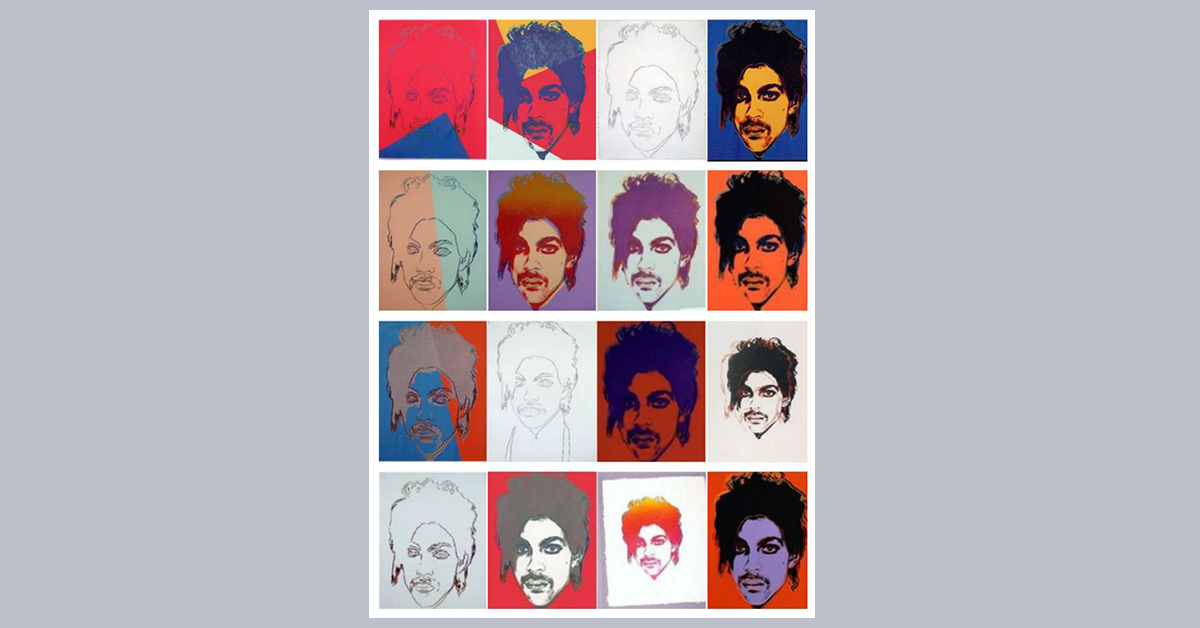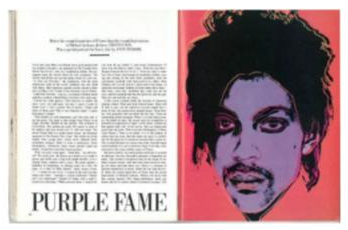
15 Jun Goldsmith vs Andy Warhol Foundation: drawing the line between copyright and fair use
The US Supreme Court ruled on 18 May that the Andy Warhol Foundation (AWF) infringed the copyright of the celebrity photographer Lynn Goldsmith by licensing a silkscreen print created by Andy Warhol with Prince’s face based on a photo of which she was the author.

A bit of background:
In 1981, Lynn Goldsmith took a picture of the singer and performer Prince for the New York magazine Newsweek. Three years later, Vanity Fair magazine commissioned Andy Warhol to create silkscreen prints of the singer’s face based on Goldsmith’s photo; she accepted and was compensated with $400 for the use of her picture as reference material for the purple silkscreen:

In 2016, on the occasion of the singer’s death, Condé Nast magazine published a new image of Warhol’s silkscreen print, in orange:

This time, only the AWF was asked for permission and received a compensation of more than $10,000.
As a result of this second publication, the photographer discovered that Warhol had created other works from her photo, apart from the one initially published by Vanity Fair, and sued AWF for having licensed the publication of this work without having sought her permission, mentioned her authorship of the photo that constituted the reference material, or compensated her financially.
After a seven-year court battle and two previous contradictory decisions, the Supreme Court of the United States of America has ruled in Goldsmith’s favour, declaring that her copyright in the photo was infringed.
Fair Use?
AWF did not argue before the Supreme Court that Goldsmith’s photo and Warhol’s silkscreen print were not substantially similar. The debate was centered on whether the use made could be covered by the “fair use” exception.
Under US copyright law, one of the factors in considering the use of another work to be fair – which AWF claimed in this case – is to take into account the purpose and character of the use.
AWF argued that fair use was made because Prince’s new series of silkscreen prints were transformative and that they conveyed a different meaning or message than the photo.
However, as we have indicated above, the Court has not accepted this interpretation, arguing that, although the expression of a new idea or concept may be relevant to consider that a copy has a character of its own, this is not the only factor to be taken into account in assessing the exception of fair use.
In this regard, the Court has taken into account that both the photograph and the silkscreen had the same purpose: to illustrate stories about Prince in the press and that, in addition, the use was commercial in nature (in exchange for a price) and therefore concludes that there has been an infringement of the photographer’s copyright.
What would happen in Spain?
Our Intellectual Property Law (IPL) grants authors the exclusive right to authorize or prohibit the reproduction, distribution, permit access to the public by any means of public communication and transformation of their works.
Therefore, in principle, if an author wants to use another author’s work to incorporate it into his or her own work or is interested in modifying a pre-existing work to create a new one, he or she needs the authorization of the author of the original work. This scenario is foreseen in article 21 of the IPL, which contemplates the scenario of transforming a pre-existing work and provides that the work resulting from the transformation shall correspond to the author of the latter, without prejudice to the right of the author of the pre-existing work to authorize the exploitation of those results.
With regard to “fair use”, our legislation recognizes some cases where another person’s work could be used without the author’s permission (articles 31 et seq. IPL), for example, to guarantee access to culture, education or information.
We therefore consider that the same issue would have had a similar outcome in Spain.
Sometimes it is difficult to draw the line between inspiration and copying and also between fair and unfair use. At Curell Suñol, experts in Industrial and Intellectual Property, we will be delighted to help you if you need advice on copyright.
Link to the Judgement: https://www.supremecourt.gov/opinions/22pdf/21-869_87ad.pdf
Author: Sílvia Oliver Codina, Lawyer at Curell Suñol.



